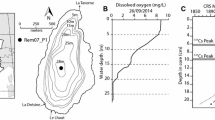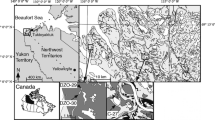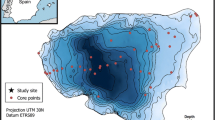Abstract
Studies addressing within-lake variability of fossil chironomid assemblages are very few, and all deal with hydrologically stable temperate lakes where the question of spatial integration mostly relates to the mixing of faunal assemblages associated with shallow, warm-water habitat and those associated with deeper, cold-water habitat. Here we study within-lake variability of surface-sediment chironomid assemblages in the fairly large (∼100–170 km2 since 1983) and shallow (Z max = 5–8 m) fluctuating tropical lake basin of Lake Naivasha, Kenya, and compare the patterns observed with those in two smaller adjacent basins, one similarly shallow (Lake Oloidien, 5.1–5.7 km², 5–8 m), the other deep and stratified (Crescent Island Crater, 1.9 km2, 14–17 m). Chironomid assemblages were analysed in core-top samples and surface sediments along inshore to offshore transects, and how well individual samples represented the total (basin-wide mean) subfossil assemblage was considered both in terms of taxon richness and taxon percent composition. Within-lake variability of subfossil chironomid concentrations (with generally higher absolute values in nearshore samples) could be explained by effects of sediment winnowing and focusing, whereas between-lake variability reflected their relative susceptibility to wind-driven sediment disturbance or bottom anoxia. In all study lakes, but most significantly in lakes Naivasha and Oloidien, species distribution in the subfossil chironomid assemblages showed a strong nearshore to offshore gradient, which in these shallow lakes, reflects the dominant control of substrate and food quality on species distribution in the living community. Particularly in the larger basins, nearshore samples better represented the total lake assemblage than offshore samples, because the former always contained a component of mud-dwelling species whereas the latter often lacked a component of macrophyte-dwelling species. Our results show that although sedimentation dynamics in the shallow, wind-stressed Lake Naivasha is dominated by frequent resuspension and random sediment redistribution, the near- to offshore gradient in chironomid habitat remains imprinted on subfossil assemblages. We conclude that also in shallow fluctuating lakes, given sufficient size, incomplete pre-burial spatial integration of habitat-specific chironomid assemblages can be exploited for within-lake calibration of environmental gradients.





Similar content being viewed by others
References
Anderson NJ (1990) Variability of diatom concentrations and accumulation rates in sediments of a small lake basin. Limnol Oceanogr 35:497–508
Armitage P, Cranston PS, Pinder LCV (1995) The chironomidae: biology and ecology of non-biting midges. Chapman and Hall, New York, 572 pp
Barker P, Gasse F, Roberts N, Taieb M (1991) Taphonomy and diagenesis in diatom assemblages—a late pleistocene palaeoecological study from Lake Magadi, Kenya. Hydrobiologia 214:267–272
Battarbee RW, Flower RJ (1984) The inwash of catchment diatoms as a source of error in sediment-based reconstructions of pH in an acid lake. Limnol Oceanogr 29:1325–1329
Bengtsson L, Enell M (1986) Chemical analysis. In: Berglund BE (ed) Handbook of holocene palaeoecology and palaeohydrology. Wiley, New York, pp 484–496
Blais JM, Kalff J (1995) The influence of lake morphometry on sediment focusing. Limnol Oceanogr 40:582–588
Bray JR, Curtis JT (1957) An ordination of upland forest communities of southern Wisconsin. Ecol Monogr 27:325–349
Brierley B, Harper D, Thomas R (1987) Water chemistry and phytoplankton studies at Lake Naivasha: short-term spatial and temporal variations. In: Harper DM (ed) Studies on the Lake Naivasha ecosystem 1982–1984. University of Leicester, Leicester, pp 35–72
Brinkhurst RO (1974) The benthos of lakes. MacMillan Press, London, 190 pp
Brodersen KP, Lindegaard C (1999) Classification, assessment and trophic reconstruction of Danish lakes using chironomids. Freshw Biol 42:143–157
Brundin L (1949) Chironomiden und andere bodentiere der Südschweden Urgebirseen. Report of the Institut of Freswater Research. Drottningholm 30:1–914
Charles DF, Dixit SS, Cumming BF, Smol JP (1991) Variability in diatom and chrysophyte assemblages and inferred pH: paleolimnological studies of Big Moose Lake, New York, USA. J Palaeolimnol 5:267–284
Clark F, Beeby A, Kirby P (1989) A study of the macroinvertebrates of lakes Naivasha, Oloidien and Sonachi, Kenya. Rev Hydrobiol Trop 22:21–33
Cranston PS (1995) Introduction to the chironomidae. In: Armitage P, Cranston PS, Pinder CV (eds) The chironomidae: the biology and ecology of non-biting midges. Chapman & Hall, New York, pp 1–7
Darlington JPEC (1977) Temporal and spatial variation in the benthic invertebrate fauna of Lake George, Uganda. J Zool 181:95–111
Davis MB, Brubaker LB (1973) Differential sedimentation of pollen grains in lakes. Limnol Oceanogr 18:635–646
Davis MB, Ford J (1982) Sediment focusing in Mirror Lake, New Hampshire. Limnol Oceanogr 27:137–150
Dean WE (1999) The carbon cycle and biochemical dynamics in lake sediments. J Paleolimnol 21:375–393
Digerfeldt G (1986) Studies on part lake-level fluctuations. In Berglund BE (ed) Handbook of holoocene palaeoecology and palaeohydrology. Wiley, pp 127–143
Eggermont H, Verschuren D (2003) Impact of soil erosion in tributary drainages on the benthic invertebrate fauna of Lake Tanganyika, East Africa. Biol Conserv 113:99–109
Eggermont H, Verschuren D (2004a) Subfossil chironomidae from East African low- and mid-elevation lakes. 1. Tanypodinae and orthocladiinae. J Paleolimnol 32:383–412
Eggermont H, Verschuren D (2004b) Subfossil chironomidae from East African low- and mid-elevation lakes. 2. Chironomini and Tanytarsini. J Paleolimnol 32:413–455
Eggermont H, Heiri O, Verschuren D (2006) Fossil chironomidae (Insecta; Diptera) as quantitative indicators of past salinity in African lakes. Quat Sci Rev 25:1966–1994
Frey DG (1988) Littoral and offshore communities of diatoms, cladocerans, and dipterous larvae, and their interpretation in paleolimnology. J Paleolimnol 1:179–191
Gaudet JJ, Melack JM (1981) Major ion chemistry in a tropical African lake basin. Freshw Biol 11:309–333
Gouder de Beauregard AC, Harper D, Malaisse F, Symoens JJ (1998) Dynamique récente et cartographie de la végétation aquatique (1960–1996) du lac Naivasha (Rift Valley Kenya). Meded Zitt K Acad Overzeese Wet 44:373–389
Graham AA, Burns CW (1983) Production and ecology of benthic chironomid larvae (Diptera) in Lake Hayes, New Zealand, a warm-monomictic eutrophic lake. Int Rev Ges Hydrobiol 68:351–377
Håkanson L (1977) The influence of wind, fetch, and water depth on the distribution of sediments in Lake Vanern, Sweden. Can J Earth Sci 14:397–412
Hare L, Carter JCH (1987) Chironomidae (Diptera, Insecta) from the environs of a natural West African lake. Ent Scand Suppl 29:65–74
Harrison AD (1987) Chironomidae of five central Ethiopian Rift Valley lakes. Ent Scand Suppl 29:39–43
Harrison AD (1993) Dicrotendipes pilosimanus kieffer: a description of all life stages, and features which distinguish it from dicrotendipes septemmaculatus (Becker) (Insecta, Diptera: chironomidae). Ann Cape Prov Mus (Nat Hist) 18:357–370
Heiri O (2004) Within-lake variability of subfossil chironomid assemblages in shallow Norwegian lakes. J Paleolimnol 32:67–84
Heiri O, Birks HJB, Brooks SJ, Velle G, Willassen E (2003) Effects of within-lake variability of fossil assemblages on quantitative chironomid-inferred temperature reconstructions. Palaeogeogr Palaeoclimatol Palaeoecol 199:95–106
Heiri O, Lotter AF (2001) Effect of low count sums on quantitative environmental reconstructions: an example using subfossil chironomids. J Paleolimnol 26:343–350
Hilton J (1985) A conceptual framework for predicting the occurrence of sediment focusing and sediment redistribution in small lakes. Limnol Oceanogr 30:1131–1143
Hilton J, Lishman JP, Allen PV (1986) The dominant processes of sediment redistribution and focusing in a small, eutrophic, monomictic lake. Limnol Oceanogr 31:125–133
Hofmann W (1986) Chironomid analysis. In: Berglund BE (ed) Handbook of holocene palaeoecology and palaeohydrology. Wiley, Chichester, pp 715–727
Hofmann W (1988) The significance of chironomid analysis (Insecta: Diptera) for paleolimnological research. Palaeogeogr Palaeoclimatol Palaeoecol 62:501–509
Iovino AJ (1975) Extant chironomid populations and the representativeness and nature of their remains in lake sediments. PhD thesis, Indiana University, IN, 54 pp
Kansanen PH (1986) Information value of chironomid remains in the uppermost sediment layers of a complex lake basin. Hydrobiologia 143:159–165
Kibret T, Harrison AD (1989) The benthic and weed-bed faunas of Lake Awassa (Rift Valley, Ethiopia). Hydrobiologia 174:1–15
Lewis WM (1983) A revised classification of lakes based on mixing. Can J Fish Aquat Sci 40:1779–1787
Likens GE, Davis MB (1975) Post-glacial history of Mirror Lake and its watershed in new hampshire USA: an initial report. Verh Int Ver Limnol 19:982–993
Mackay AW, Battarbee RW, Flower RJ, Granin NG, Jewson DH, Ryves DB, Sturm M (2003) Assessing the potential for developing internal diatom-based transfer functions for Lake Baikal. Limnol Oceanogr 48:1183–1192
Magurran AE (1998) Ecological diversity and its measure. Princeton University Press, Princeton
McLachlan AJ, McLachlan SM (1971) The bottom fauna and sediments in a drying phase of a saline African lake (L. Chilwa, Malawi). Hydrobiologia 34:401–413
Mees F, Verschuren D, Nijs R, Dumont HJ (1991) Holocene evolution of the crater lake at Malha, Northwest Sudan. J Paleolimnol 5:227–253
Melack JM (1979) Photosynthetic rates in four tropcial African freshwaters. Freshw Biol 9:555–571
Milbrink G (1977) On the limnology of two alkaline lakes (Nakuru and Naivasha) in the East Rift Valley system in Kenya. Int Rev Ges Hydrobiol 62:1–17
Moos MT, Laird KR, Cumming B (2005) Diatom assemblages and water depth in lake 239 (Experimental Lakes Area, Ontario): implications for paleoclimatic studies. J Paleolimnol 34:217–227
Oliver DR, Roussel ME (1983) The genera of larval midges of Canada (Diptera: Chironomidae). Res. Branch, Agric. Can. Ottawa. Publ. No. 1746, 263 pp
Pinder LCV (1986) Biology of freshwater chironomidae. Ann Rev Entomol 31:1–23
Pinder LCV (1995) The habitats of chironomid larvae. In: Armitage P, Cranston PS, Pinder LCV (eds) The chironomidae: the biology and ecology of non-biting midges. Chapman and Hall, London, pp 107–135
Primer-E ltd (2001) Primer Version 5.2.4. Roborough, Plymouth, UK
Quinlan R, Smol JP (2001) Setting minimum head capsule abundance and taxa deletion criteria in chironomid-based inference models. J Paleolimnol 26:327–342
Reineck HE, Singh IB (1980) Depositional sedimentary environmentals. Springer, Berlin
Rowan DJ, Kalff J, Rasmussen JB (1992) Profundal sediment organic content and physical character do not reflect lake trophic status, but rather reflect inorganic sedimentation and exposure. Can J Fish Aquat Sci 49:2490–2497
Schmäh A (1993) Variation among fossil chironomid assemblages in surficial sediments of bodensee-untersee (SW-Germany): implications for paleolimnological interpretation. J Paleolimnol 9:99–108
Stark DM (1976) Paleolimnology of Elk Lake, Itasca State Park, Northwestern Minnesota. Arch Hydrobiol Suppl 50:208–274
StatSoft Inc. (1998) STATISTICA for Windows [Computer program manual]. StatSoft Inc., 2300 East 14th Street, Tulsa, OK 74104, USA. Web: http://www.statsoft.com
Ter Braak CJF (1986) Canonical correspondence analysis: a new eigenvector technique for multivariate direct gradient analysis. Ecology 67:1167–1179
Ter Braak CJF (1995) Ordination. In: Jongman R II, ter Braak CJF, van Tongeren OFR (eds) Data analysis in community and landscape ecology. Cambridge University Press, Cambridge, pp 91–173
Ter Braak CJF, Prentice IC (1988) A theory of gradient analysis. Adv Ecol Res 18:271–317
Ter Braak CJF, Šmilauer P (1998) CANOCO reference manual and user’s guide to canoco for windows. Centre for Biometry Wageningen, Wageningen, 351 pp
Tokeshi M (1995) Production ecology. In: Armitage P, Cranston PS, Pinder LCV (eds) The chironomidae: the biology and ecology of non-biting midges. Chapman and Hall, London, pp 269–296
Verschuren D (1996) Comparative paleolimnology in a system of four shallow, climate-sensitive tropical lake basins. In: Johnson TC, Odada E (eds) The limnology, climatology and paleoclimatology of the East African lakes. Gordon and Breach, New York, pp 559–572
Verschuren D (1997) Taxonomy and ecology of fossil chironomidae (Insecta, Diptera) from Rift Valley lakes in central Kenya. Arch Hydrobiol Suppl 107:467–512
Verschuren D (1999) Influence of depth and mixing regime on sedimentation on a small, fluctuating tropical soda lake. Limnol Oceanogr 44:1103–1113
Verschuren D, Tibby J, Sabbe K, Roberts CN (2000) Effects of lake level, salinity and substrate on the invertebrate community of a fluctuating tropical lake. Ecology 81:164–182
Verschuren D, Johnson TC, Kling HJ, Edgington DN, Leavitt PR, Brown ET, Talbot MR, Hecky R (2002) History and timing of human impact on Lake Victoria, East Africa. Proc R Soc Lond B 269:289–294
Walker IR (1987) Chironomidae (Diptera) in paleolimnology. Quaternary Sci Rev 6:29–40
Walker IR (2001) Midges: chironomidae and related diptera. In: Smol JP, Birks HJB, Last WM (eds) Tracking environmental change using lake sediments. Zoological indicators, vol 4. Kluwer Academic Publishers, Dordrecht, pp 43–66
Walker IR, Fernando CH, Paterson CG (1984) The chironomid fauna of four shallow humic lakes and their representation by subfossil assemblages in surficial sediments. Hydrobiologia 112:61–67
Walker IR, Paterson CG (1985) Efficient separation of subfossil chironomidae from lake sediments. Hydrobiologia 122:189–192
Wiederholm T (1978) Vänerns vattenkvalitet. Bottenfauna I Vänern. In: SNV 1978, Vänern en naturresurs. Liber, Stockholm, pp 168–184
Wiederholm T (1979) Chironomid remains in recent sediments of Lake Washington. Northwest Sci 53:251–256
Zhao Y, Sayer CD, Birks HH, Hughes M, Peglar SM (2006) Spatial representation of aquatic vegetation by macrofossils and pollen in a small and shallow lake. J Paleolimnol 35:335–350
Acknowledgements
The fieldwork for this study was conducted with research permission from the Office of the President of Kenya to Prof. K. M. Mavuti (University of Nairobi). We thank David Harper, Nzula Kitaka and Jo Verschuren for field assistance, and Oliver Heiri, John Smol and an anonymous referee for constructive comments on the manuscript. H.E. is postdoctoral fellow with the Fund for Scientific Research of Flanders (FWO-Vlaanderen).
Author information
Authors and Affiliations
Corresponding author
Rights and permissions
About this article
Cite this article
Eggermont, H., De Deyne, P. & Verschuren, D. Spatial variability of chironomid death assemblages in the surface sediments of a fluctuating tropical lake (Lake Naivasha, Kenya). J Paleolimnol 38, 309–328 (2007). https://doi.org/10.1007/s10933-006-9075-9
Received:
Accepted:
Published:
Issue Date:
DOI: https://doi.org/10.1007/s10933-006-9075-9




